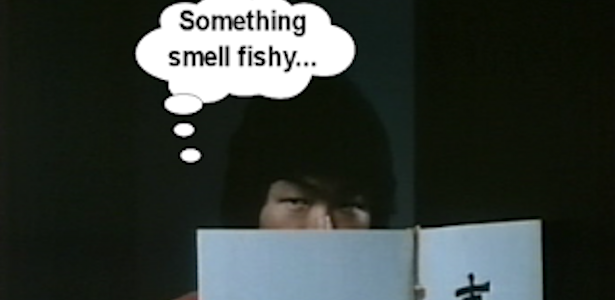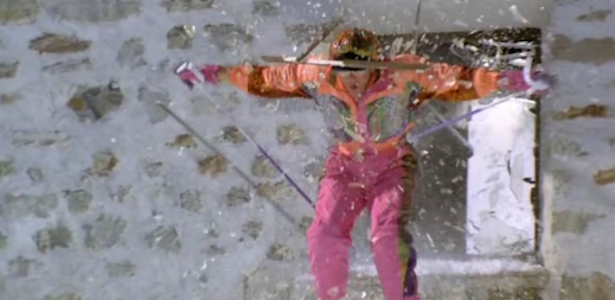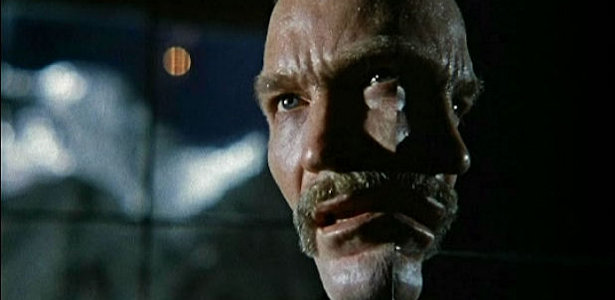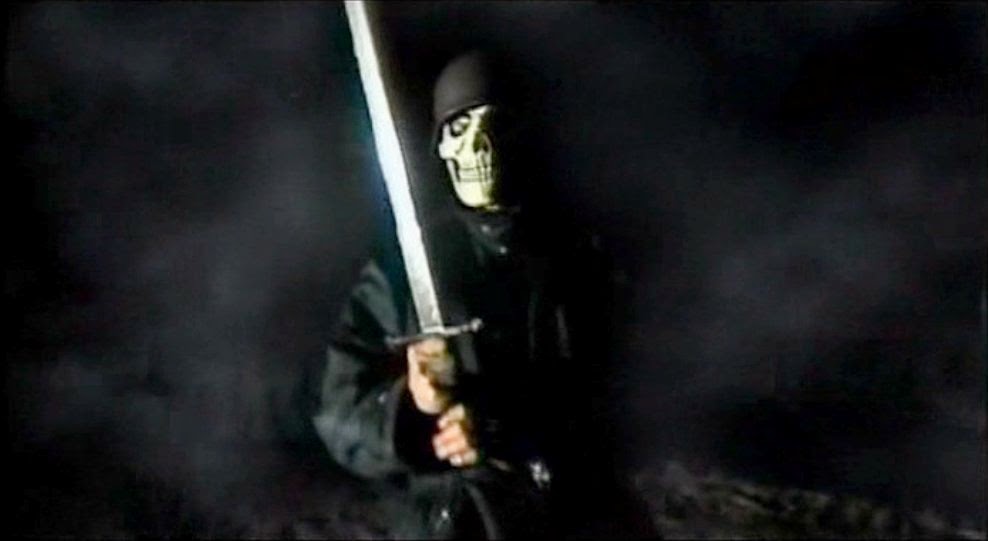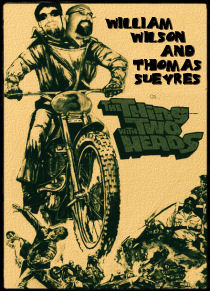 Welcome to our newest “Theme Week” (guaranteed to last a month). Yes, we’ve recovered from covering Bud Spencer and his EXTRA LARGE world that we felt we could handle another run of quasi-related reviews. We’ve been all over the map with regard to our choices in the past, so we figured why not hit the biggest location of them all: the ocean.
Welcome to our newest “Theme Week” (guaranteed to last a month). Yes, we’ve recovered from covering Bud Spencer and his EXTRA LARGE world that we felt we could handle another run of quasi-related reviews. We’ve been all over the map with regard to our choices in the past, so we figured why not hit the biggest location of them all: the ocean.Covering 70% of our little globe (thank you, Google) the ocean has long been a source of human nightmares. From the Ancient Greeks to JAWS (1975), we’ve always found a way to scare the hell out of ourselves thinking about what lurks in the deep blue sea. While it would be foolish for us to lay the genesis of cinema’s obsession with all things aquatic at one thing, we’ll do it anyway. Jules Verne’s 19th century novel Twenty Thousand Leagues Under the Sea will always bee seen as a crucial point of oceanic fantasy authority. The book’s profound influence on the shaping of cinema can be seen early on as Georges Méliès adapted it into a ten minute silent short in 1907; a feature length silent version from Universal emerged nine years later in 1916. Most folks, however, will cite the 1954 Disney version 20,000 LEAGUES UNDER THE SEA as a defining moment in combining science fiction and the sea.
It is precisely that combination that has spurred filmmakers ever since and what has drawn us to covering this world. (Okay, I’ll be honest. It was a badass Thai poster for DEEPSTAR SIX that got us on this topic.) While planning this, we had few basic rules. First, a majority of the films had to take place underwater. This will keep aquatic beasties who come to land like CREATURE FROM THE BLACK LAGOON (1954) or HUMANOIDS FROM THE DEEP (1980) out of our overview. Second, an underwater station as the main location was preferable. Finally, the most important rule, Tom had dibs on reviewing J.P. Simon’s THE RIFT (1989), even though we already reviewed it. Anyway, if you feel like throwing on your wetsuit and going for a plunge, join us as we dive into Abyss-mal Cinema. Just make sure you come up slowly as you don’t want the bends.
Naturally, a great place for us to take our first plunge is in the waterlogged year of 1989. Now think what you want about James Cameron, but there is no denying he was a powerhouse at the time with THE TERMINATOR (1984) and ALIENS (1986) being considered insta-classics. Being huge box office hits didn’t hurt either. So when the sci-fi wunderkind announced in 1987 that his next project was going to be about aliens found underwater, everyone quickly followed (wet)suit. Every producer suddenly had an entry in submerged cinema under development; from big studios like MGM to the ever reliable exploitation master Roger Corman (our review of his 1989 entry LORDS OF THE DEEP can be read here). First to make a splash theatrically was Sean S. Cunningham of FRIDAY THE 13th (1980) fame as he got DEEPSTAR SIX into theaters in January 1989.
The film drops the audience 5,200 fathoms (approximately six miles) into the deep sea at Deepstar Six, a state-of-the-art underwater construction facility tasked with building missile platforms for the U.S. Navy. After some gorgeous underwater credits, we open with submarine pilot McBride (Greg Evigan) in bed with Joyce Collins (Nancy Everhard) as they discuss the relationship that has blossomed between them in the six months they’ve been down here. Care to guess which two characters are going to survive the events of this film? McBride is quite a charmer, telling her she wouldn’t like a loner type like him and no doubt knocking her off her feet by saying, “You’re like one of the guys.” We quickly meet the other members of this cranky, eleven member crew. There is Dallas played by Tom Skerritt and Parker played by Yaphet Kotto…ah, crap, wrong film. We have station captain Philip Laidlaw (Taurean Blacque); project head Dr. John Van Gelder (Marius Weyers); marine biologist Scarpelli (Nia Peebles); other sub pilot Jim Richardson (Matt McCoy); Russian geologist Burciaga (Elya Baskin); Navy mechanic Snyder (Miguel Ferrer); underwater construction dudes Hodges (Thom Bray) and Osborne (Ronn Carroll); and doctor Diane Norris (Cindy Pickett). Pop quiz – looking over that cast, can you tell me who is going to be the asshole who finally snaps under the pressure?
The plot kicks into motion when a cavern is discovered right where the team is supposed to place a missile platform. Of course, Van Gelder freaks out for some reason and wants those missiles in place “by the end of the week.” And you thought your job was high stress? The team decides the best course of action is to blow up the cavern to see how deep it is. Get used to the idea of these supposedly smart folks doing dumb stuff. Hodges and Osborne send in a remote camera and promptly lose the feed. So what do they do? Disengage their sub and go after it against orders. Bad news as we get a recreation of the “they’re closing in” monitor scene from ALIENS as the duo’s sub is taken out by something huge. Collins and Burciaga are in the monitoring post when they lose contact and then were get a second recreation of that ALIENS scene as something huge rams their station. Back at Deepstar Six, they can’t reach either team so Laidlaw and McBride head out to investigate. Once again, we get the ALIENS blip scene for the third time in fifteen minutes as something huge comes charging at their mini-sub, but backs off when they kill the lights.
Docking with the teetering observation post, Laidlaw and McBride find Collins and Burciaga up to their necks in water. Oddly, McBride never asks a simple question like “what happened?” Burciaga shows his flair for Russian dramatics as he dies the moment the rescuers arrive. During the rescue Laidlaw gets nearly split in half when a metal door collapses on him. He screams, “Save yourselves” before opting to flood the entire vessel. Jeez, was he trying to “out drama” the Russian guy? And, yes, there really are buttons on the wall that say FLOOD and PURGE on them. McBride and Collins make it back to the mini-sub just in time and you just know he is finally going to ask her what happened. Nope! He gives her his wet sweater to warm her up and they hold hands and talk about how much they love each other.
Back at the main base, Collins finally tells someone what happened. Naturally, her description of something huge attacking their vessel piques the interest of Scarpelli and she suggests it could be a phenomenon where aggressive fish are drawn to
 bright light. While getting checked out by the doc, it is revealed that Collins has two different heartbeats. “What was that,” wonders the dense McBride. “That was our baby’s heartbeat,” Collins says. Oh Jesus. Like bubbles through the snorkel, so are the days of our lives. Can we have somebody get bit by a sea monster now? With four casualties in one afternoon, the group gets the go ahead to abandon their work and head topside. Of course, Van Gelder is pissed. He tells Snyder to secure the missiles and this leads us to perhaps the greatest/stupidest plot contrivance every put on film. I’m not kidding you. I’ve seen a lot of films and this one is a doozy. In typing up the commands to secure the missiles, Snyder is prompted by the computer for a reason. He is given three options for the missile shutdown: 1. Repair or removal 2. natural forces or 3. an act of aggression. He calls Collins to re-verify her story and ask what he should put in. She says it was aggressive so he goes with choice three. This results in the computer stating that all the nuclear missiles will be detonated. Let me repeat that – all the nuclear missiles will be detonated! Snyder somehow doesn’t feel the need to confer with anyone about this and within a minute they have several nuclear missiles exploding about a mile from them. The resulting shockwave rocks the station and, naturally, incapacitates anything they need like oxygen or the decompression unit on the escape pod.
bright light. While getting checked out by the doc, it is revealed that Collins has two different heartbeats. “What was that,” wonders the dense McBride. “That was our baby’s heartbeat,” Collins says. Oh Jesus. Like bubbles through the snorkel, so are the days of our lives. Can we have somebody get bit by a sea monster now? With four casualties in one afternoon, the group gets the go ahead to abandon their work and head topside. Of course, Van Gelder is pissed. He tells Snyder to secure the missiles and this leads us to perhaps the greatest/stupidest plot contrivance every put on film. I’m not kidding you. I’ve seen a lot of films and this one is a doozy. In typing up the commands to secure the missiles, Snyder is prompted by the computer for a reason. He is given three options for the missile shutdown: 1. Repair or removal 2. natural forces or 3. an act of aggression. He calls Collins to re-verify her story and ask what he should put in. She says it was aggressive so he goes with choice three. This results in the computer stating that all the nuclear missiles will be detonated. Let me repeat that – all the nuclear missiles will be detonated! Snyder somehow doesn’t feel the need to confer with anyone about this and within a minute they have several nuclear missiles exploding about a mile from them. The resulting shockwave rocks the station and, naturally, incapacitates anything they need like oxygen or the decompression unit on the escape pod. broken line or something. He says he thinks he saw something (you and me both, pal) before losing contact. They pull him back into the loading area and – finally – that big ol’ monster leaps in and chomps him in half. Well, we assume that is what happens as he is whole in one shot and in half in the next as the scene obviously got ravaged by the MPAA. As they struggle to shut the tank, no one notices this big monster sliding in. Soon it makes a meal of Scarpelli (Italian food is the best) and our five remaining survivors safely lock themselves away from it. That is until they realize they need to repair an air line…in the same room the monster is chilling in. Armed with shark darts and shotguns (your guess is as good as mine as to why they have shotguns), they reenter so that McBride can fix this hose. Of course, the monster pops up and Snyder proceeds to chicken the fuck out. He accidentally stabs Van Gelder in the back with a dart, causing his chest to explode (another victim of MPAA cutting). And now we are down to four as you the remaining folks must find a way to defeat this monster and deal with Snyder cracking up.
broken line or something. He says he thinks he saw something (you and me both, pal) before losing contact. They pull him back into the loading area and – finally – that big ol’ monster leaps in and chomps him in half. Well, we assume that is what happens as he is whole in one shot and in half in the next as the scene obviously got ravaged by the MPAA. As they struggle to shut the tank, no one notices this big monster sliding in. Soon it makes a meal of Scarpelli (Italian food is the best) and our five remaining survivors safely lock themselves away from it. That is until they realize they need to repair an air line…in the same room the monster is chilling in. Armed with shark darts and shotguns (your guess is as good as mine as to why they have shotguns), they reenter so that McBride can fix this hose. Of course, the monster pops up and Snyder proceeds to chicken the fuck out. He accidentally stabs Van Gelder in the back with a dart, causing his chest to explode (another victim of MPAA cutting). And now we are down to four as you the remaining folks must find a way to defeat this monster and deal with Snyder cracking up. Cunningham seems to have forgotten the basics when it comes to making an action movie. Filmed as DEEP 6, the script, written by Lewis Abernathy and Geof Miller, was first mentioned in Variety in October 1987. The interesting thing is that this wasn’t just some pre-THE ABYSS (1989) cash in as Abernathy and Cameron were diving buddies. Apparently Cameron got pissed at Abernathy for making something similar and it caused a – wait for it – rift in their friendship. (Things got patched up when Abernathy, a Titanic historian, gave Cameron a script about that boat’s sinking; funny how that works.) According to what Miller told Fangoria, they had written the script to be a low budget feature ($100,000 - $200,000) to make but it grew substantially when Cunningham got involved and made it an $8,000,000 movie. Unfortunately, the script wasn’t fleshed out enough. Time after time, you will see these character who are smart people do the dumbest things. Yes, nothing can top Snyder thinking it was okay to detonate nuclear missiles (“I was just following protocol,” he screams in his defense), but some of the stuff is just downright embarrassing. If you are a fan of actors screaming random techno-babble though (“The cooling primary to the reactor was destroyed. It will go super critical in a few hours!”) this is for you. Also, if you have a fetish for shots of screens displaying technical stuff, this is a veritable orgy of pixel pornography.
Cunningham seems to have forgotten the basics when it comes to making an action movie. Filmed as DEEP 6, the script, written by Lewis Abernathy and Geof Miller, was first mentioned in Variety in October 1987. The interesting thing is that this wasn’t just some pre-THE ABYSS (1989) cash in as Abernathy and Cameron were diving buddies. Apparently Cameron got pissed at Abernathy for making something similar and it caused a – wait for it – rift in their friendship. (Things got patched up when Abernathy, a Titanic historian, gave Cameron a script about that boat’s sinking; funny how that works.) According to what Miller told Fangoria, they had written the script to be a low budget feature ($100,000 - $200,000) to make but it grew substantially when Cunningham got involved and made it an $8,000,000 movie. Unfortunately, the script wasn’t fleshed out enough. Time after time, you will see these character who are smart people do the dumbest things. Yes, nothing can top Snyder thinking it was okay to detonate nuclear missiles (“I was just following protocol,” he screams in his defense), but some of the stuff is just downright embarrassing. If you are a fan of actors screaming random techno-babble though (“The cooling primary to the reactor was destroyed. It will go super critical in a few hours!”) this is for you. Also, if you have a fetish for shots of screens displaying technical stuff, this is a veritable orgy of pixel pornography.Cunningham claimed he wanted to move away from the slasher mold, but this is nothing more than that with slower pacing. It also doesn’t help that he ends the film with a FRIDAY THE 13th-esque scare moment. To be fair, there is some good work on display here on the technical side. The photography by the always reliable Mac Ahlberg is gorgeous and Mark Shostrom’s team has constructed a great creature. Sadly, we never get to see it that much. Audiences responded in kind when DEEPSTAR SIX came out. It opened in eighth place the weekend of January 17, 1989 and promptly sank like a stone in the following weeks with a final box office haul of $8,143,225. The next underwater feature to surface was LEVIATHAN (1989) a few months later in March. I’ll let Tom handle that as I have to get this water out of my ears.






